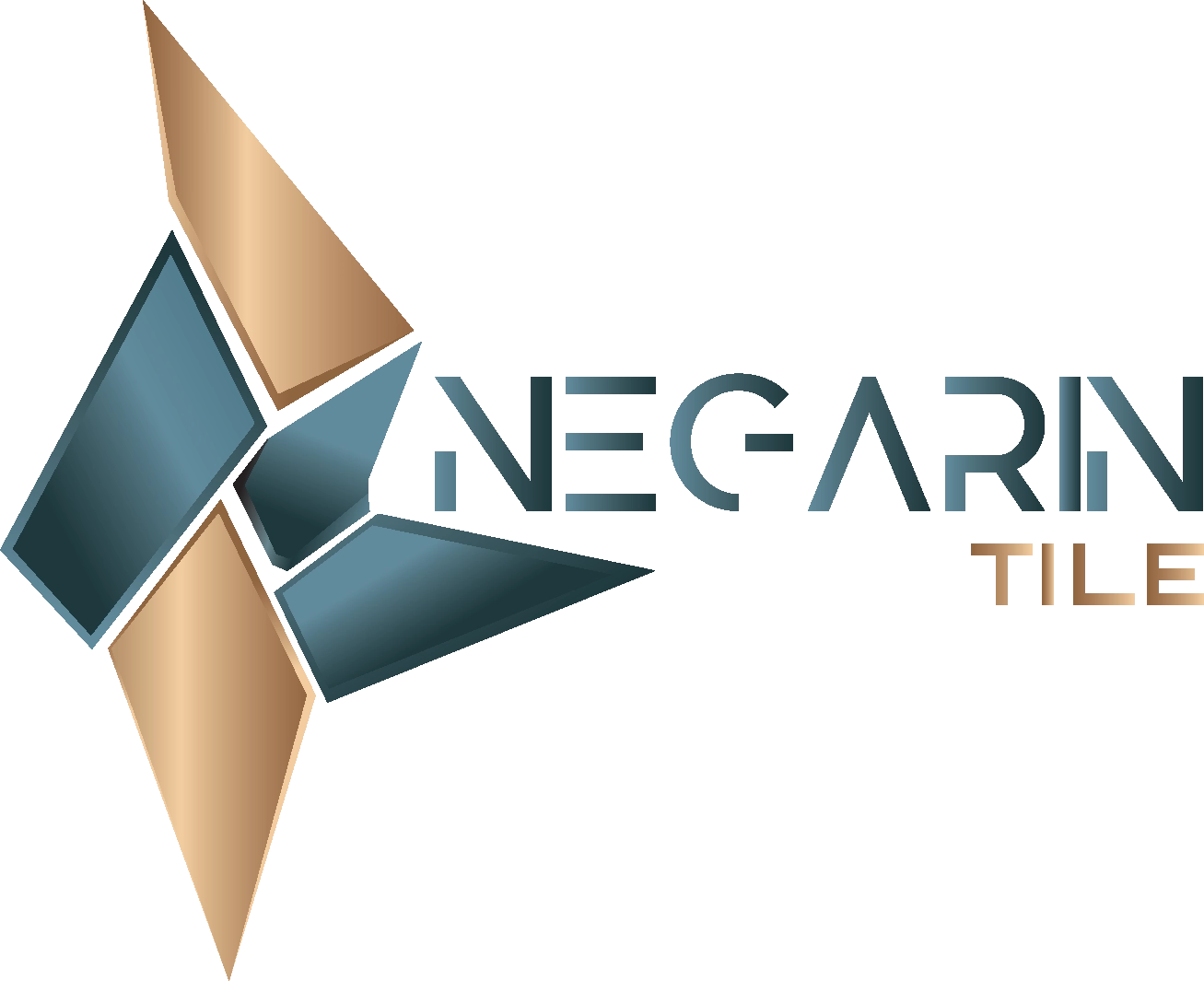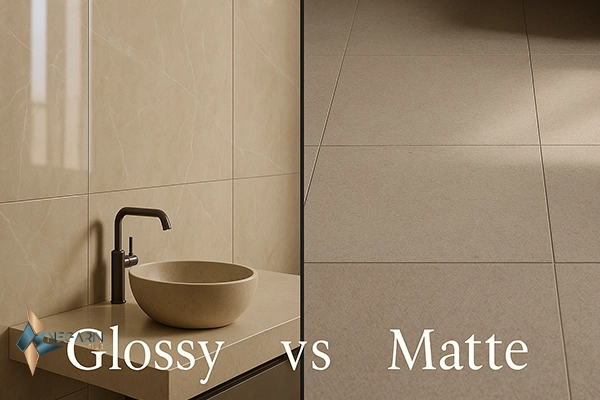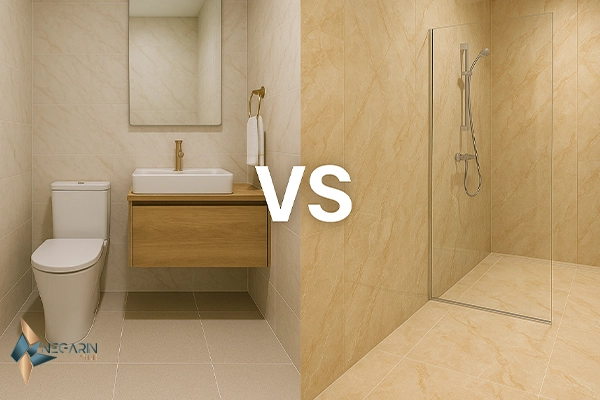Glossy vs matte tiles: glossy finishes reflect more light and boost contrast—ideal for walls, splashbacks, and feature panels where you want a bright, luxe look. Matte finishes diffuse glare, hide footprints, and typically offer better perceived traction—making them the practical choice for floors and wet areas. Choose finish by function first (DCOF/maintenance), then by style.
This guide compares glossy vs matte tiles in real projects so you can match function, safety, and design.
Introduction
Finish is as important as color or size. When buyers compare glossy vs matte tiles, they’re weighing light reflectance, perceived traction, maintenance routines, and design intent. In short, the same colorway in two finishes can behave like two different products. This guide gives you a quick table, 21 practical differences, room-by-room recommendations, maintenance plans, design pairings, and checklists you can take to site.
When homeowners weigh glossy vs matte tiles, the smartest path is to decide by function first and style second.
Quick Comparison — Glossy vs Matte Tiles (What to Choose)
The table below puts glossy vs matte tiles side by side for a fast, at-a-glance decision.
| Factor | Glossy Tile | Matte Tile | What it means |
|---|---|---|---|
| Light reflectance | High; brightens & dramatizes | Low; soft & glare-free | Gloss for sparkle, matte for calm |
| Perceived traction | Smoother feel when wet | Grippier feel; textures available | Floors in wet zones usually lean matte |
| Wet DCOF | Product-specific | Often higher in matte/structured | Always check the datasheet |
| Footprints & splashes | Show more (esp. dark colors) | Largely hidden | Matte is forgiving in busy homes |
| Cleaning pattern | Wipes fast; may streak if not dried | Hides streaks; textured matte needs brushing | Both prefer neutral-pH cleaners |
| Veining contrast | Stronger, crisper | Softer, naturalistic | Choose the mood you want |
| Grout visibility | More contrast, more “grid” | Blends joints | Narrow rectified joints help both |
| Photography | Can glare/hot-spot | Even in photos & downlights | Matte behaves better with harsh light |
| Best placement | Walls, splashbacks, features | Floors, wet rooms, entries | Function first, then style |
| Cost | Usually similar | Usually similar | Specialty polishes/anti-slips can vary |
| Long-term look | Shows micro-scuffs more | Hides wear better | Entry mats and felt pads help both |
Pro tip: never pick glossy vs matte tiles on body material alone. Safety on floors is about finish texture and wet DCOF, not simply porcelain or ceramic.
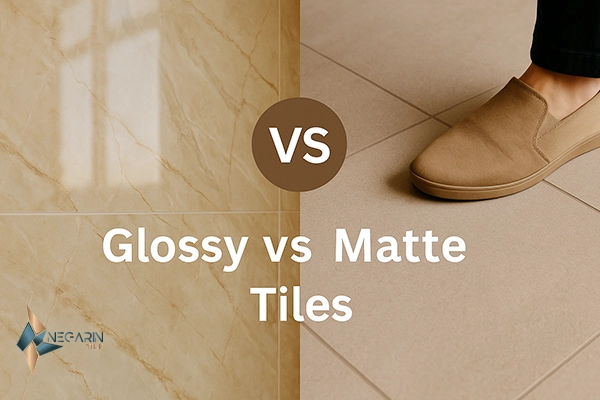
What “finish” really changes (and why it matters)
When you compare glossy vs matte tiles, you’re deciding how the surface interacts with light, feet, cleaning tools, and cameras. Finish changes: light behavior, slip confidence, visibility of marks, color/vein contrast, photographic glare, and the cadence of everyday maintenance—precisely the factors that determine long-term satisfaction.
21 Proven Differences (Deep Dive)
1) Light Reflectance (GU) & Perceived Brightness
Glossy finishes bounce light and visually enlarge compact rooms; matte scatters glare for gallery-level calm.
2) Contrast & Pattern Readability
Gloss amplifies marble/onyx veining and gemstone flecks; matte softens the pattern for an authentic stone vibe.
3) Glare Management under Downlights
Spotlights + gloss can create hot spots; matte reads even, especially in kitchens and retail.
4) Wet DCOF & Slip Confidence
Matte/structured options often post higher wet DCOF numbers. For floors in wet zones, many specifiers start matte by default.
5) Perceived Traction vs Measured Numbers
Even with similar DCOF values, users report matte feels safer—perception matters in the glossy vs matte tiles decision.
That’s why many specifiers default to matte when the brief is glossy vs matte tiles for wet floors.
6) Footprints, Water Spots & Hand Marks
Gloss (especially dark) shows more; matte hides day-to-day prints and splash marks.
7) Cleaning Routine
Glossy wipes fast but may need a dry buff; textured matte prefers a soft brush plus neutral-pH cleaner.
8) Micro-Scuffs & Long-Term Aesthetics
High-gloss dark floors can show micro-scuffs earlier; matte disguises them, especially in corridors.
9) Color Temperature & Finish
Warm ambers and beiges glow under gloss; cool greige stones look ultra-architectural in matte.
10) Visual Continuity with Grout
Gloss increases grout contrast; matte blends it. Rectified edges (2–3 mm joints) elevate both.
With glossy vs matte tiles, rectified edges and 2–3 mm joints keep either finish looking premium.
11) Photography & Video
On camera, gloss can blow highlights; matte is camera-friendly—useful for showhomes and brand content.
12) Acoustic Feel
Matte spaces feel visually “quieter”; gloss feels crisp and lively.
13) Tactile Feel
Gloss is sleek and cool; matte feels stone-true and soft underfoot.
14) Stain Perception
Both glazed finishes resist stains; cleaner residue is simply more visible on gloss if not rinsed/dried.
15) Edge Chip Visibility
If chips occur, gloss can highlight them; matte is slightly more forgiving to the eye.
16) Pattern Direction & Finish
Herringbone dazzles in gloss; monolithic slabs feel serene in matte.
17) Wayfinding & Visual Comfort
Matte avoids bright reflection lines that can distract in long corridors; structured mattes add stability.
18) Cost & Availability
Most lines are parity; premium high-polish and heavy anti-slip textures can vary.
19) Maintenance Frequency
Gloss invites showroom-level perfection; matte stretches the time between visible cleans.
20) Sustainability & Lighting
Gloss can reduce artificial lighting demand in dark corners; matte prevents wasteful glare in over-lit rooms.
21) Resale & Trend Longevity
Gloss sells “hotel luxe”; matte sells “quiet luxury.” Both are timeless when paired with classic neutrals.
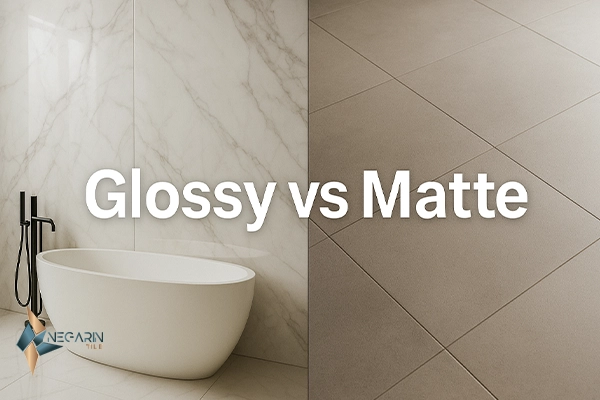
Glossy vs Matte Tiles: Which One Fits Your Room?
Ask three questions:
- Is the surface a floor in a wet or high-traffic area? If yes, begin with matte/structured and confirm DCOF.
- Do you prefer bright sparkle or calm minimalism? Go glossy for shine and high contrast; matte for soft presence.
- What’s your maintenance tolerance? Gloss wants perfect wiping; matte hides life better.
Understanding where glossy vs matte tiles diverge helps you avoid costly finish mistakes.
Room-by-Room Matrix for Glossy vs Matte Tiles
| Space | Floor | Walls | Notes |
|---|---|---|---|
| Bathroom (family) | Matte/structured (check wet DCOF) | Gloss for brightness or matte for spa calm | Mosaics or small cuts on shower floor |
| Powder room | Matte | Gloss feature behind vanity | High drama with safe footing |
| Kitchen | Matte (for grip) | Gloss splashback | Quick wipe-downs, low glare under downlights |
| Living / Open plan | Matte for daylight control | Either | Glossy feature panels add depth |
| Entry / Mudroom | Structured matte | Either | Darker grout to hide soil |
| Retail / Light-commercial | Matte/structured | Gloss accents | Verify slip data and cleaning schedule |
| Covered outdoor (rated) | Matte/structured | — | Confirm exterior/frost ratings |
If you’re unsure, map traffic and water exposure first, then decide glossy vs matte tiles.
Design Pairings (with Negarin examples)
- Balanced combo (most projects): matte floor + glossy wall. Example: SOHA Beige or EMAD Cream matte on floors, ALFA Ivory or LANDA Beige glossy on walls.
- Full gloss statement: MORVARID glossy (gemstone/onyx collage) as a feature wall; keep floors matte.
- All-matte quiet luxury: AZARRAKHSH Cream base with JIHAN Greige matte for subtle warmth.
When you curate glossy vs matte tiles like this, you get function and drama in one palette.
Installation & Grout Playbook
Execution matters as much as the choice of glossy vs matte tiles—edges, joints, and leveling define the result.
Joints & edges
- Rectified: 2–3 mm (premium, minimal grid).
- Pressed: 3–4 mm (absorbs size tolerance).
Orientation
- Large formats (60×120) = fewer joints; check substrate flatness and use leveling clips.
- Stack-bond for minimalism; 1/3 offset on rectangulars to cut lippage.
Adhesives
- Use high-bond thinset for low-absorption porcelain; back-butter large tiles.
Movement joints
- Respect perimeter gaps and use profiles at transitions—critical on sun-exposed floors.
Maintenance & Cleaning Schedules
Weekly
- Sweep/vacuum grit; mop with neutral-pH cleaner.
- Glossy: finish with a dry microfiber to avoid streaks.
- Textured matte: soft brush to lift soil from micro-relief.
Monthly
- Inspect grout lines; touch up and clean edges.
- Refresh entry mats to keep grit outside.
Seasonal
- Seal grout if specified; glazed tiles rarely need sealing themselves.
A neutral-pH routine works for both, so daily care won’t decide glossy vs matte tiles on its own.
Lighting & Finish Synergy
Lighting can flip a glossy vs matte tiles decision—dim rooms love glossy walls; glare-heavy rooms love matte floors.
- North-facing/dim rooms: add glossy wall panels to bounce light; keep floors matte for safety.
- South-facing/harsh daylight: matte floors avoid reflections; add selective glossy accents for sparkle.
- Retail downlights & cameras: matte floors for even captures; glossy features to highlight merchandise.
Common Mistakes (and fixes)
- Gloss on slippery entries. → Choose matte/structured and verify wet DCOF.
- Matte everywhere in a dark bathroom. → Add glossy wall tiles to lift light.
- Streaks on gloss. → Neutral-pH cleaner + final dry buff; avoid oily/acidic products.
- Heavy texture behind cooktops. → Use glossy splashbacks for easy wipe-downs.
- Wide grout with glossy floors. → Rectified edges + 2–3 mm joints; match grout tone.
Case Studies (real-world playbooks)
Case 1 — Small Powder Room, 1.5 × 2.0 m
- Walls: ALFA Ivory glossy to expand space.
- Floor: AZARRAKHSH Cream matte with 2 mm joints.
- Outcome: luxe brightness with safe footing.
Case 2 — Family Kitchen-Diner, 4.2 × 6.0 m
- Floor: SOHA Beige matte 60×60 for grip and low glare.
- Splashback: 30×60 sliced to 15×60 glossy bands.
- Outcome: quick wipe-downs near cooking; calm floor under downlights.
Case 3 — Boutique Retail Corridor
- Floor: JIHAN Greige matte (check slip data).
- Feature: MORVARID glossy panels near POS.
- Outcome: camera-friendly floors; jewel-box wall drama.
Case 4 — Ensuite with Skylight
- Shower walls: LANDA Beige glossy (light bounce).
- Shower floor: matte mosaic (wet DCOF).
- Vanity wall: matte slab to avoid mirror glare lines.
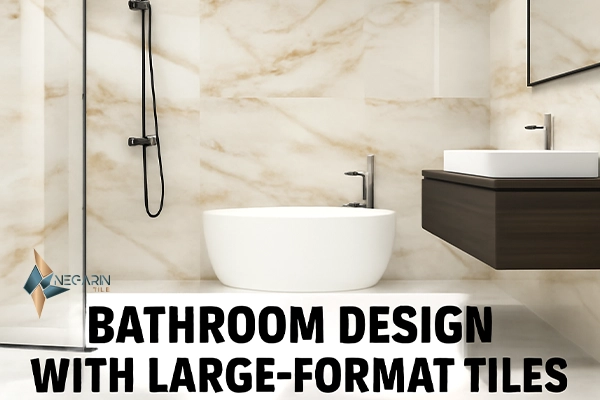
Selection Framework (print-friendly)
- Area use: floor/wall? wet/dry? traffic?
- Safety: confirm wet DCOF for floors—matte/structured wins most wet zones.
- Lighting: dim → add glossy walls; glare → prefer matte floors.
- Maintenance tolerance: showroom gloss vs forgiving matte.
- Design intent: luxe sparkle (gloss) or quiet luxury (matte).
- Execution: rectified edges, 2–3 mm joints, matched grout tone.
Use this checklist anytime you compare glossy vs matte tiles for a new space.
More information
- Marble-Look Porcelain 60×60 → (SOHA, EMAD, AZORIT)
- Onyx-Look Porcelain → (ALFA, LANDA, MORVARID)
- Micro-Stone & Terrazzo Looks → (MAHA, AZARRAKHSH)
- Related reads: Porcelain vs Ceramic Tiles, Tile Size Guide 2025
Execution matters because internal links help search engines connect glossy vs matte tiles to your product ranges.
Conclusion (Key Takeaways)
In the end, the glossy vs matte tiles choice is simple: matte (or structured matte) for floors and wet zones; glossy for walls and feature areas. Choose finish by function first, then style it for your lighting and mood. Lock in rectified edges, narrow joints, matched grout, and a neutral-pH cleaning habit—your project will look premium for years.
Order two samples to compare glossy vs matte tiles under your own lighting before you commit.
Frequently Asked Questions
Are glossy tiles OK for bathroom floors?
Only if the product’s wet DCOF meets your local requirement. Most homes are better served by matte/structured floors.
Do matte tiles stain more easily?
Both glazed finishes resist stains. Matte hides marks better; textured matte benefits from a soft brush during cleaning.
Which is easier to clean—glossy vs matte tiles?
Glossy wipes quickly but may streak unless dried. Smooth matte is equally easy; heavier textures need periodic brushing.
Can I mix glossy and matte in one room?
Yes—matte floors for function and glossy walls for brightness and drama is a proven combination.
Do I need to seal glossy or matte tiles?
Glazed tiles typically do not need sealing; grout often does. Follow the tile and grout manufacturer guidance.
Will glossy tiles scratch more?
Both are durable, but gloss may show micro-scuffs sooner, especially in dark colors. Use entrance mats and felt pads.
Which finish works best with large format tiles (60×120)?
Both finishes work. Matte reads monolithic under daylight; gloss turns large slabs into dramatic, mirror-like features—great for accent walls.
What grout width should I use?
Rectified edges: 2–3 mm; pressed edges: 3–4 mm. Matching grout tones reduce the grid effect, especially with glossy floors.
Is glossy slippery by definition?
No. Slip resistance depends on surface texture and wet DCOF, not the name of the finish.
What’s the best finish for a dark, windowless bathroom?
Use glossy wall tiles to bounce light and matte or structured tiles on the floor for grip and comfort.
Can I use glossy on kitchen floors?
It’s possible in low-splash zones, but matte is generally more forgiving near cooktops and sinks.
Can I use glossy on kitchen floors?
Clean with a neutral-pH solution and finish with a dry microfiber buff. Avoid oil-based or acidic cleaners that leave haze.
